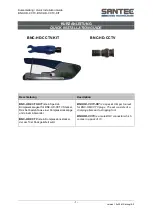
for low pressure only. The red light labeled
“OVHT” will illuminate if the overheat switch
senses a leading-edge temperature above nor-
mal limits. The light could be an indication that
the automatic controller is malfunctioning
and may be accompanied by the amber SEN-
SOR FAIL light. Illumination of the OVHT
light is accompanied by illumination of the red
flashing OVHT warning light on the center in-
strument panel.
Should an overheat occur, the anti-icing sys-
tem must be selected off. The anti-icing valves
will close, allowing the wings to cool. When
the OVHT lights extinguish, the crew may se-
lect STANDBY mode as required and closely
monitor the OVHT warnings.
Pressing the L HEAT or R HEAT switchlight will
perform a test of the heat and overheat detec-
tion circuitry and illuminate both L HEAT and
R HEAT lights, the OVHT light, and both L
FAIL and R FAIL lights. In addition, the OVHT
light on the center instrument panel will flash.
The red DUCT FAIL light on the anti-icing
panel illuminates if a bleed-air leak is de-
tected in the wing anti-icing ducting.
The wing anti-icing duct fail detection system
operates in the same manner as the normal
bleed leak detection system. The wing anti-
icing system, however, is equipped with only
a single detection loop instead of two paral-
lel detection loops. When a bleed-air leak is
detected in the wing anti-icing system, the
red DUCT FAIL light will illuminate, the mas-
ter DUCT FAIL warning light on the center in-
strument panel will flash, and the location of
the bleed leak will be displayed on the bleed-
air leak annunciator panel behind the copilot.
Operation of the bleed-air leak detection sys-
tem is discussed in Chapter 9, “Pneumatics.”
ELECTRICALLY OPERATED
SYSTEMS
General
The windshields and exterior air data systems
(ADS) components are anti-iced electrically.
The ADS components include the pitot-static
probes, the angle-of-attack vanes, the total air
temperature probe, and the alternate static ports.
Windshield Anti-icing-
Defogging
General
The windshield anti-icing system is designed
to accomplish two functions: (1) provide an an-
tifogging capability to the windshield and side
window panels (Figure 10-8) and (2) provide
an anti-icing capability to the forward wind-
shield panels only.
Operation
The windshield and side windows are of lam-
inated acrylic construction. Each panel in-
corporates a conductive metallic coating which
heats the panel when electric current is applied.
FlightSafety Canada
L t é e
L t d .
CL-600-2B16 PILOT TRAINING MANUAL
10-8
CL 601-3A/R
FOR TRAINING PURPOSES ONLY
Figure 10-8. Windshield and Side Window
Panels
















































